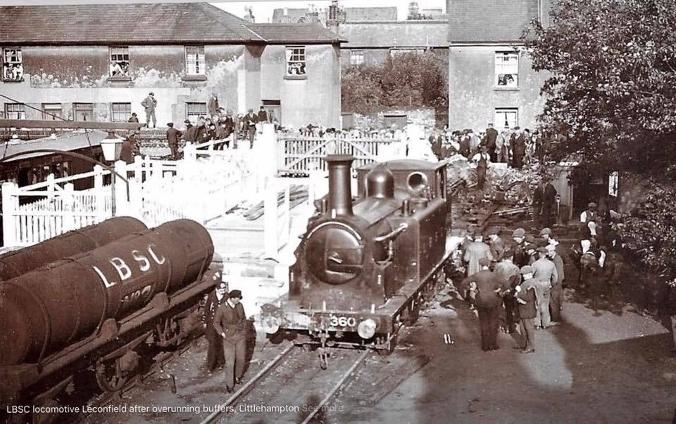
LITTLEHAMPTON STATION
4th AUGUST 1920
Involving Littlehampton
Driver Edwards & his Fireman Chapman
EXTRACTED AND ADAPTED FROM THE REPORT BY
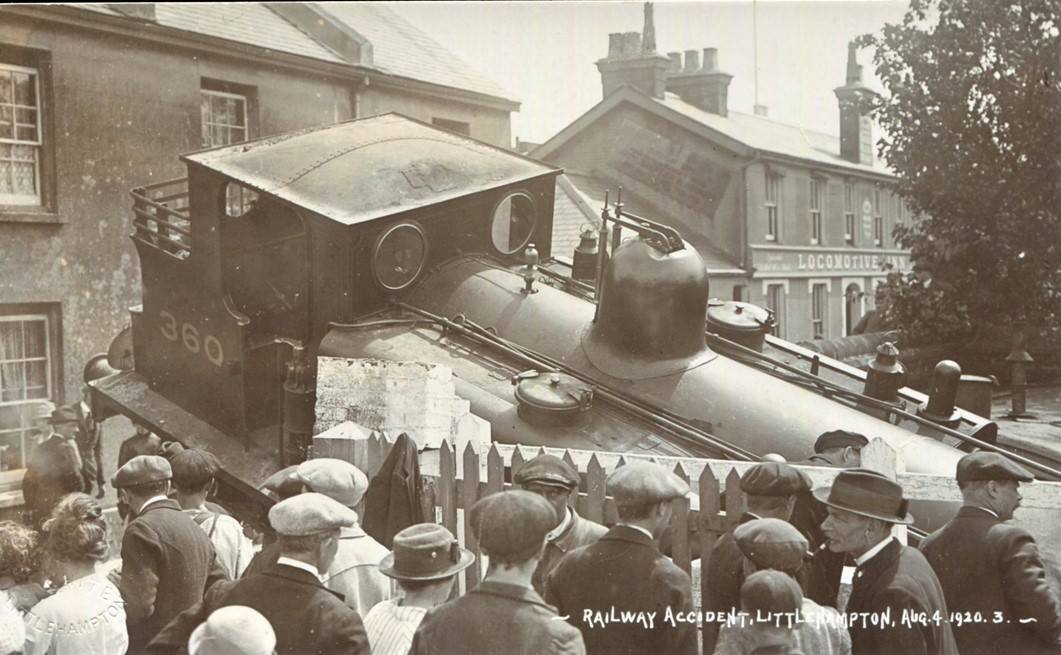
At the 1.10 p.m. train from Ford Junction Station was running into Littlehampton terminal station, the brakes failed to act; with the result that the engine struck the bent rail buffer stops, demolishing them and a brick boundary wall behind ; and the engine eventually came to rest with one half of its length across the public road.
There were about thirty passengers in the train, of whom thirteen suffered from minor injuries, or from the effects of shock. The driver and fireman escaped injury by jumping from the foot-plate just before the collision occurred.
The train comprised passenger side tank engine No. 360 (type 0-4-2); not fitted for motor service, running bunker first, with the under mentioned eight vehicles :--
No. 1327 8-wheeled, 3rd class trailer car (vestibuled).
No. 133 6 wheeled 3rd class trailer car.
No. 137 6 wheeled brake-van.
No. 1767 6 wheeled 3rd class coach.
No. 400 6 wheeled compo. coach.
No. 418 6 wheeled compo. coach.
No, 1678 6 wheeled 3rd class coach.
No. 162 6 wheeled brake-van.
It was fitted throughout with the Westinghouse continuous air-brake, blocks on all wheels of the engine and coaches except the centre pairs of the 6-wheeled. The weight of the engine in working order was 434 tons and of the vehicles, 121 tons 24 cwts. The proportion of the un-braked weight of the latter was approximately 24 tons.
In addition to the engine the leading pair of wheels of the first vehicle was derailed.
The damage to the leading car was alone considerable, including the distortion of 9 solebars, 2 diagonals and cross bearers, together with breakage of end and side panels and vestibule.
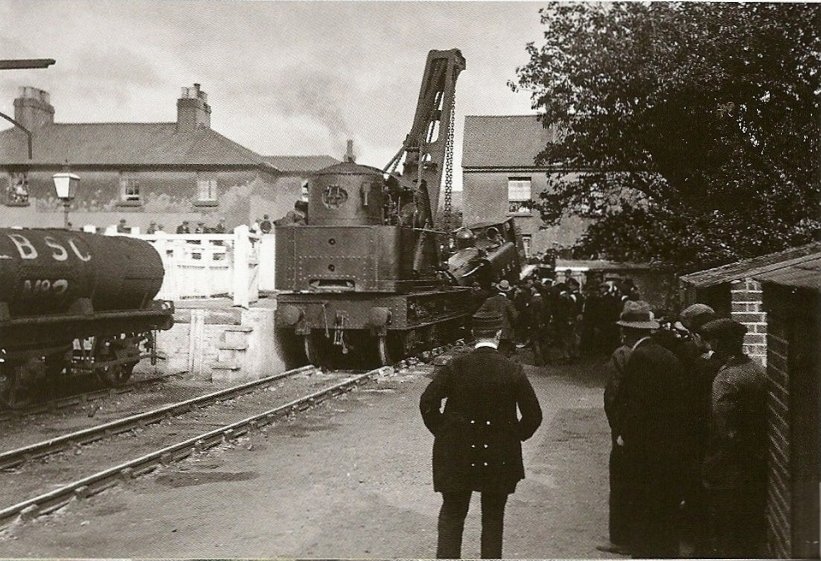
Description.
The double line of the Littlehampton branch has a general direction from north-west to south-east. The length of the branch between Ford Station and the terminal buffers at Littlehampton is about two miles. The road is practically straight with slight curvature northward as it approaches Littlehampton. The platform in the station has a line on east side, the northern line having considerably the greater length.
Measured from the buffer stops, the approximate distances to the under mentioned signals, etc., are :--
East end of platform, top of ramp . . . . 37 yards W.
Ticket barrier on platform . . . . . , 76 yards
West end of platform, top of ramp . . . , 257 yards I )
Down inner home signals . . . . . . . . 268 yards
Littlehampton signal-box on north side of railway 349 yards
Down outer home signals . . . . . . 557 yards
Up starting signal . . . . . . . . .. l008 yards,
Down distant signal . . . . . . . . 1330 yards
A down train from Ford Station travels over generally falling gradients to 9 about 800 yards of the down distant signal where the road becomes Level. After passing the distant signal, the gradients are as follows :-
Rising, 1 in 170, 165 yards long ;
Level, 605 yards ;
Rising, to buffer stops, 1 in 330, 560 yards.
2. The two 8-wheeled vehicles at the leading end of this train were of the type known as trailer-stock, and used in motor services. To avoid the necessity for reversing the position of the locomotive at a terminal station, they are arranged so that the train can be driven either from the foot-plate of the engine, or from the leading compartment of a trailer car.
The cars are therefore fitted with four air-pipes instead of the usual single Westinghouse main train-pipe, and with four hose-pipe couplings at each end. The diameter of the union head in each case is 1 inch. Unless the trailer vehicles are attached to an engine fitted for motor service work, three out of the four hose pipe couplings are disused. The Westinghouse main train-pipe coupling occupies the standard position at the end of these cars, i.e., immediately on the left of the screw coupling, and is painted black. The three other hose pipe couplings, to distinguish them from the main train-pipe, are painted red, but, as in this case, the red paint soon becomes so discoloured as not to be recognisable from black. Each of the four pipes has a plate affixed, either over or alongside it,, which carries in raised lettering the name of the pipe, i.e., back pressure, main Westinghouse, main storage, and regulator.
In the driving compartment of each of these cars, there is a driver's brake valve to which the main storage and main Westinghouse pipes are connected, and from which the continuous air brake is applied and released as required, when t,he cars are in motor service, and are propelled by the engine.
When, as in this case, trailer cars are used to supplement the stock upon an ordinary train, the driver's valve in the cars should be in the neutral position, and the handle removed.
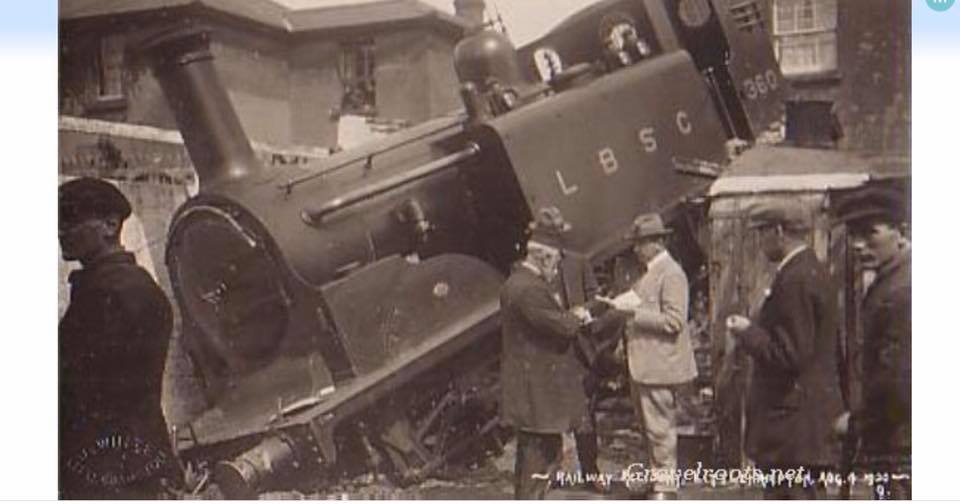
2. The two 8-wheeled vehicles at the leading end of this train were of the type known as trailer-stock, and used in motor services. To avoid the necessity for reversing the position of the locomotive at a terminal station, they are arranged so that the train can be driven either from the foot-plate of the engine, or from the leading compartment of a trailer car.
The cars are therefore fitted with four air-pipes instead of the usual single Westinghouse main train-pipe, and with four hose-pipe couplings at each end. The diameter of the union head in each case is 1 inch. Unless the trailer vehicles are attached to an engine fitted for motor service work, three out of the four hose pipe couplings are disused. The Westinghouse main train-pipe coupling occupies the standard position at the end of these cars, i.e., immediately on the left of the screw coupling, and is painted black. The three other hose pipe couplings, to distinguish them from the main train-pipe, are painted red, but, as in this case, the red paint soon becomes so discoloured as not to be recognisable from black. Each of the four pipes has a plate affixed, either over or alongside it,, which carries in raised lettering the name of the pipe, i.e., back pressure, main Westinghouse, main storage, and regulator.
In the driving compartment of each of these cars, there is a driver's brake valve to which the main storage and main Westinghouse pipes are connected, and from which the continuous air brake is applied and released as required, when t,he cars are in motor service, and are propelled by the engine.
When, as in this case, trailer cars are used to supplement the stock upon an ordinary train, the driver's valve in the cars should be in the neutral position, and the handle removed.
Conclusion
The case has unsatisfactory features, in that neglect', on the part of a number of Railwaymen, of the General Regulations for working the Westinghouse Automatic Brake, and Instructions for coupling and uncoupling engines, is proved. In the Appendix mill be found extracts from the General Regulations and instructions relevant to the case.
The 12.55 pm. train from Littlehampton with the above-mentioned stock arrived at Ford Station at 1.4 pm. Driver Edwards stated that there was no real difficulty in stopping the train at the proper place, but that he had to use a greater quantity of air (about. 30 Ibs.) than usual. On arrival at Ford the engine was uncoupled by porter Dinnage, ran round, and backed on to the coaches at the other end.
Dinnage explained that it was ordinarily the duty of one of the shunters to couple and uncouple, but that during the dinner hour the duty devolved upon him and the other porters once in a month, for a week at a time. He had continuous experience of coupling for seven weeks when one of the shunters was &sent owing to illness, but bad only on one or two occasions previously had to couple trailer cars. He had never received any instruction in the work from the station foreman or shunters, and some months had elapsed since he had been required to couple a trailer car to an engine not fitted for motor service. He stated that, after the train arrived, he disconnected file hose pipe between the engine and the front vehicle, uncoupled and then applied t'he brake on the coaches by opening (and afterwards closing) the tap on the hose coupling on van No. 152. He then went along the platform to the other end of the train, and got down on to the ballast after the engine had backed on to the train. He unscrewed the engine coupling as far as possible, but was unable to get the link over the draw-bar hook of the coach, so he opened the tap on the train pipe of car No. 1327 to apply the brake further, and then called on the driver to ease up.
This was done and he was then able to hook on and screw up the coupling. As he stood with the screw coupling between himself and the platform, he reached over the coupling and took hold of the engine hose pipe with his right hand ; he then took hold of the second hose pipe coupling, counting from the side of the car furthest from the platform, with his left hand, connected them over the screw coupling, and opened their respective taps.
He heard the sound of air passing through the pipes, but could not say whether release of the brake blocks on the coaches was thereby effected. Nor did he remember whether there was the u s d clicking noise of the brakes releasing. He then got under the screw coupling, re-mounted the platform, and did not see whether any action was taken by the station foreman or the guard to examine the couplings. He mentioned that lit was difficult to read the name plates of the hose pipes, especially on trailer cars fitted as in this case, with a vestibule. He noticed that the driver had to set back before the train could start away.
Dinnage gave his evidence quite frankly. He thought he made the hose pipe connections in the manner described, but admitted that he did not know it would make any difference which of the two centre hose pipes on the car connected to the engine pipe.Also, that the only reason he had for selecting the particular coupling in this case was that he had noticed that hose couplings always cross the screw couplings when they are connected.
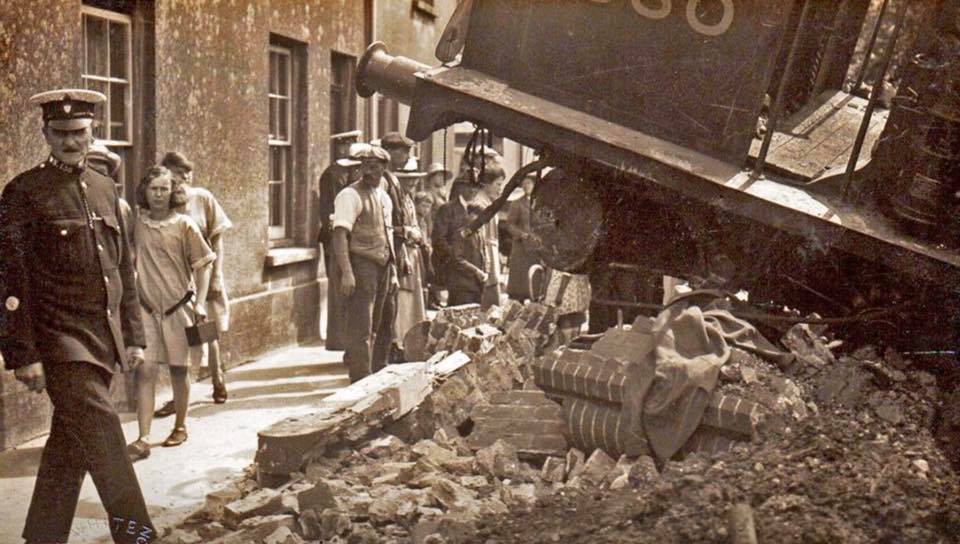
The train was delayed at Ford Station owing to the late arrival of a train from Brighton, and, instead of leaving at 1.10 p.m. in accordance with the schedule, did not leave until 1.27 pm. It therefore stood at the platform for nearly 20 minutes after Dinnage had coupled the engine to the train.
Passenger guard Fribbins stated that he travelled in brake No. 137 from Littlehampton to Ford, and there changed into brake-van No. 152. Trailer car 1327 was first coupled for service that morning at 11.45, but the first occasion on which Fribbins travelled with the car was when he took charge of the 12.55 pm. train horn Littlehampton. He had not heard in the past of any difficulty experienced by drivers in connection with the working of the continuous brake on these trains, and had himself on other occasions worked trains of similar composition. The train travelled from Littlehampton and stopped at Ford in the usual manner. He did not see the engine coupled to car No. 1327, and took no particular notice of the actual air gauge readings in his van. But he saw, after the engine was coupled, that the pressure in the gauge increased more slowly than usual. He did not make the brake test prescribed in the Regulations, as he thought that having seen the pressure rise from 20 to 70 lbs. was sufficient. There was a slight delay after he gave the driver the signal to start, whilst the train was set back a few feet,. Re thought the pressure in his air gauge was about 70 lbs. when the train started, but did not actually observe it,. The train travelled towards Littlehampton in the usual way and at no greater speed, i.e., about 25 miles an hour. He did not notice whether the brake was applied on the journey, and heard no brake whistle sounded by the driver. In accordance with his usual practice he applied the hand brake on his van as he passed the signal-box. After the collision he observed that the pressure in the gauge had been reduced. He remembered at 8.50 am. that morning, when trailer car 1336 was first attached to the train, that delay was caused by an escape of air from one of the control levers in the car. This was remedied by the driver tightening the valve.
Edwards, driver of the train concerned, stated that the air pressure in the train pipe and main reservoir should, in accordance with the regulations, be 70 and 90 lbs. respectively. He began work that morning by driving the 12.55 pm. train from Littlehampton to Ford and was satisfied with the working and retarding effect, of the continuous brake. It was necessary, however, to keep his brake handle in the full charging instead of the running position, apparently on account of some leakage in the brake pipe, or values, and the consequent liability of the brake blocks to become applied to the wheels. He found also that he had to use a greater amount of air than usual, say 30 lbs., to stop the train at, Ford Junction, but had no real difficulty in controlling the train. After running round at Ford and backing on to the coaches, the bunker end of the engine was leading. A porter coupled the engine at. Ford to one of the trailer type of cars, but Edwards did not, in accordance with the General Regulations, examine the couplings afterwards to see they were correctly made, though there was time to do so. He was unable to say whether the usual sound of brakes releasing throughout the train took place after the coupling way made.
He reduced the train pipe pressure on the engine considerably after coupling, and thought, erroneously as it now appears, that the increase of pressure which followed proved that the coupling had been made properly, and that the cocks were in the open position. Re agreed that he had to set back on to the coaches a short distance before it starting, but did not think that this was due to the brake blocks holding the train. His brake handle at the time was in the full charging position. He had a clear nm to Littlehampton, and shut, off steam as usual when the speed of the train was about 25 miles an hour. He commenced to apply the continuous brake in the vicinity of the down outer home signal, and found it did not have any retarding effect. He therefore used more air, but again without any result. By this time the engine was in the neighbourhood of the signal-box, and his fireman (Chapman) had commenced to use his hand brake on the engine wheels, with the result that some slight reduction in the speed of the train was being effected. He then applied the brake with full force. and experiencing no immediate and powerful retardation, called out "We are on the wrong pipe." His fireman at once applied his hand brake with full force. 'I here was a continuous strong flow of air through the valve when he made the full application of the brake, and for this reason he concluded that the Westinghouse main pipe connection between engine and train had been wrongly made. He Chen reversed and applied steam, just before reaching the inner home signal, but was unable to say what pressure the needles of his air gauge registered when he bad made his final brake application.
He did not test the continuous brake at the distant signal in the manner prescribed in the Regulations, for the reason that the speed of the train would, in ordinary circumstances, have been reduced by a half ; and it was not his practice to make the test. He estimated the speed of the train was 15 miles an hour half way along the platform, and 8 miles an hour when the engine struck the stop. He jumped off the foot-plate just before the collision took place. He did not whistle for hake assistance from the guard, nor use the communication. But he thought that if the guard had applied the Westinghouse brake from his van, retardation would have resulted.
Driver Edwards mentioned that on the 27th July last, under similar conditions, his engine was coupled at Ford to a trailer car. He saw that the porter had connected the Westinghouse train pipe of the engine to the storage pipe on the trailer car. He drew the attention the porter and also of the station master to this mistake. Having drawn attention to the mistake so recently, he did not think it was necessary to examine t.he hose pipe connection on this particular date.
Fireman Chapman confirmed the statement of Edwards in respect of the mistake in coupling on 'the-27th July, and also his evidence generally. It was his duty to apply sand from the foot-plate but he did not do so on this occasion. He jumped from the engine footplate just before the collision.
Leading porter Carpenter was standing on the platform at Littlehampton when the train passed, and confirmed the estimate 'by driver Edwards of its speed. The engine ought to have stopped at the ticket collecting barrier, and he shouted to the collector to move the barrier to prevent it fouling any doors that might be opened. He did not see the guard as the train passed, but noticed that the driver had hold of the regulator.
Mr. Horne, station master at Ford Junction stated that his attention was called by Driver 'Edwards to the incorrect coupling by, a passenger shunter, of an engine to a trailer car on, the 27th July 'last. He thought it was the first occasion that the shunter had-been called upon to couple a trailer car with a vestibule end to an engine fitted with-only one air pressure hose pipe. He called the man and drew his attention to the mistake, and impressed upon him the serious result which might 'follow. He also instructed .the second passenger shunter, but did not explain to the four porters at the station who have sometimes to do shunter's work .'H e described how the motor service for which the trailer cars were designed, ceased-in 1916 and that the stock was not again used until about two months ago, when it was utilised, whenever necessary, to strengthen ordinary Westinghouse fitted trains. He agreed it was the duty of the station master, or the foreman acting for a station master, to examine couplings on trains before they started.
Station Foreman Catchpole was in charge of Ford Station between 1 and 2 p.m. whilst station master Home was at dinner. We had not thought it necessary to explain to porter Dinnage the differences in the hose couplings at the-end of a trailer car. He expected any of the porters to come and ask for information if they were in doubt. He did not see the engine re-coupled, or the guard test the brake, or examine the coupling after connection, though he was aware that these were some of the duties of the station master.
He heard the air escape from the coaches when Dinnage opened the tap before re-coupling the engine. He saw the engine reverse before starting, but concluded that it was not on account of any difficulty -with the brakes, as he did not hear any sound of brake blocks being released.
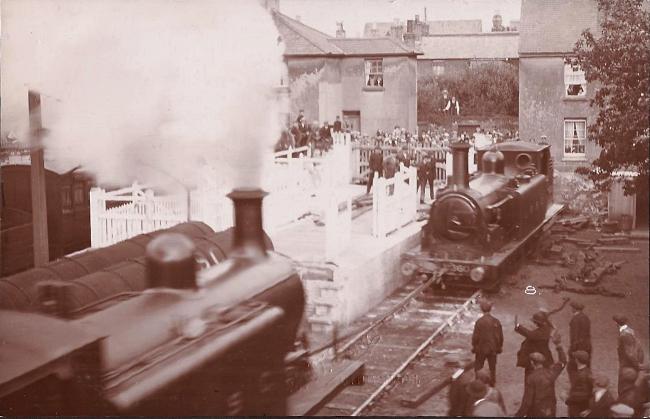
Leading porter Carpenter was standing on the platform at Littlehampton when the train passed, and confirmed the estimate 'by driver Edwards of its speed. The engine ought to have stopped at the ticket collecting barrier, and he shouted to the collector to move the barrier to prevent it fouling any doors that might be opened. He did not see the guard as the train passed, but noticed that the driver had hold of the regulator.
Mr. Horne, station master at Ford Junction stated that his attention was called by Driver 'Edwards to the incorrect coupling by, a passenger shunter, of an engine to a trailer car on, the 27th July 'last. He thought it was the first occasion that the shunter had-been called upon to couple a trailer car with a vestibule end to an engine fitted with-only one air pressure hose pipe. He called the man and drew his attention to the mistake, and impressed upon him the serious result which might 'follow. He also instructed .the second passenger shunter, but did not explain to the four porters at the station who have sometimes to do shunter's work .'H e described how the motor service for which the trailer cars were designed, ceased-in 1916 and that the stock was not again used until about two months ago, when it was utilised, whenever necessary, to strengthen ordinary Westinghouse fitted trains. He agreed it was the duty of the station master, or the foreman acting for a station master, to examine couplings on trains before they started.
Station Foreman Catchpole was in charge of Ford Station between 1 and 2 p.m. whilst station master Home was at dinner. We had not thought it necessary to explain to porter Dinnage the differences in the hose couplings at the-end of a trailer car. He expected any of the porters to come and ask for information if they were in doubt. He did not see the engine re-coupled, or the guard test the brake, or examine the coupling after connection, though he was aware that these were some of the duties of the station master.
He heard the air escape from the coaches when Dinnage opened the tap before re-coupling the engine. He saw the engine reverse before starting, but concluded that it was not on account of any difficulty -with the brakes, as he did not hear any sound of brake blocks being released.
11. All the 8 vehicles concerned in this case were worked as the 11.45 am. train from 'Littlehampton to Arundel (3 ½ miles) and returned t o Littlehampton. Edwards then drove them as the 12.55 p.m. train to Ford. Since no difficulty was experienced on these three journeys in controlling the train, and releasing the brakes, there is strong prima facie evidence 'that the Westinghouse brake equipment, in respect of leakage through the driver’s valves on the trailer car or from the train pipe to atmosphere, was at least in fair, if not in good condition. If the driver's valve on either of the two cars was out of the proper (neutral) position, or defective, there would of course be serious leakage of pressure from the main train pipe to the storage pipe. The direction of leakage would depend upon the degree of pressure in the' train and storage pipes respectively, with the tendency for the air-pressure the two pipes, to equalise. An escape of air was, as stated by guard Fribbins, noticed through the driver's valve in car l936, when it was first coupled to the six wheeled stock a& 8.50 a.m. This Leakage, he stated, was topped by the driver tightening the valve. When the trailer cars were examined some time after the accident, the valves of both trader cam were found in ;the proper neutral position. These valves, when there is any considerable pressure either in the train pipe or storage pipe, can only be operated by a spanner or brake valve handle; and in order to place a handle in position for operating the valve, and also h e h e removing a handle from the valve, it must he turned into the neutral position.
At my request, tests of the brake equipment on the two trailer cars were subsequently made by the Company, with the driver's valves in the proper neutral position. These tests showed :-
(i) That with the main storage pipe an car 1336 continuously charged to 90 lbs pressure, and the train pipe uncharged, leakage at the average rate of about 3lbs per minute took place owing to the defective condition of the regulator valve, until the pressure in the train pipe reached 75 lbs. In similar conditions there was no appreciable leakage on car 1327.
(ii) That with the main pipe continuously charged, and the main storage pipe unchanged, considerable leakage through the driver's valve took place on each car, when tested separately. Pressures were observed in each main storage pipe-of 20 lbs. after the first minute, 50 lbs. after 6 minutes, and 70 lbs. to 75lbs. after 21 minutes. leakage is of course explainable by the fact that the design of the apparatus is not calculated to withstand pressure under the rotary valve, -and the small retaining spring is insufficient to hold the valve in position.
(iii) That with the storage pipe charged to 90lbs. and the train pipe to 7Olbs. and brakes applied by a reduction of total train pipe pressure, there was no leakage and no release of the brake on car 1327. But on car1336 in similar conditions the brake released in 3 minutes. With the two cars coupled together, and a test made in the same conditions, the brakes had not entirely released in 40 minutes, although the pressure in the train pipe during the interval had been raised to 70lbs. by leakage from the storage pipe of Car 1336.
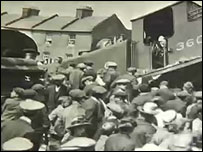
The results of these trials proved :-
(a) That in utilising cars of the trailer type with ordinary fitted stock, even when the driver's valves on the cars are in good condition, there is considerable waste of air pressure owing to leakage though the valves from the train pipe into the storage pipe and cylinder. This would, however, have no releasing effect, in the case of an application of the continuous brake upon the train.
(b) In the case of a defective regulator valve, such as existed on car1336, the pressure on the storage side of the valve would, after an application of the continuous brake had been made, tend to release the brake. But if the reduction of pressure in the brake application had been considerable, the releasing, effect would be very slow and gradual on a train of the length concerned.
III The case, therefore, turns upon whether porter Dinnage connected the main train pipes between the engine and car No. 1327, correctly or incorrectly.
If the first alternative be taken, no explanation is necessary of how the release of the brakes on the coaches, following the two applications made by Dinnage, .was effected. On the other hand, the evidence of driver Edwards and .fireman Chapman in respect of the application of the continuous brake as they approached .Littlehampton, and of its effect, must be, rejected, and responsibility for the collision would then rest with the enginemen.
Having regard to all the circumstances, I am not prepared to take this view.
The possibility of the second alternative, i.e., incorrect coupling of hose pipes, has then to be considered. There is no direct evidence on the point beyond the statement of Dinnage, since neither driver, guard, nor station foreman examined the connection before the train left, and the engine coupling after the collision was found disconnected.
On the other hand, when I examined the four hose pipe couplings belonging to car No. 1327 on the 10th August, which had been removed from the car immediately after the accident, I found distinct marks of rubbing in ,the. lusty .bearing face of the union heads of both train and storage pipes. The .existence of such marks on: the union head of the storage pipes evidence that the coupling had at all events been recently in use.
There is, moreover, it he evidence proving that an incorrect. Connection had been made on the 27th July by a shunter with 18 months' experience of-shunting and coupling. It would not, therefore, be surprising if Dinnage, with half the service and considerably less experience of coupling, made the same mistake, especially in view of the total lack of knowledge to which he confessed. Therefore, although Dinnage is very explicit in his description of his position, and actual movements, whilst connecting the hosepipes, I think, having regard to all the circumstances and the evidence, that there was failure of the continuous brake to act, due to his connecting the engine main train pipe to the storage pipe of car 1327. In leaning forward over the screw coupling to reach the engine hose pipe with his right hand, and in having also to stoop to reach any of the four hose pipes on the car, which hang free considerably below the level of screw couplings, his left hand would I think naturally be extended over the screw coupling, and this may account for his catching hold of the wrong pipe. When the taps were opened, the movement of air through the hose pipes would be audible, even though they were incorrectly coupled. If the tap he opened on this occasion to apply the continuous brake on the coaches was also that belonging to the storage pipe on the car; the opening would not cause an application of the brake.
But an explanation may be necessary of how it was possible for the brakes of the train to be released, since in accordance with Dinnage's statement, he applied them at the other end of the train after he had uncoupled the engine. There was no possibility of his making a mistake in that case, as there was only one hose pipe coupling and one tap at the end of brake-van No. 152. On this point it may be said that Dinnage may only have opened the tap to a small extent and very momentarily, with the result that the reduction in train pipe pressure may have been too small to set the brakes, though the escape of air might still be audible. It has also to be remembered that the train stood for 20 minutes after this application of the brake was made. That the application of pressure was too slight to actuate the brake, or that the brakes leaked off, is clear, otherwise the engine would not have been able to start, for there is no evidence that the brakes had to be released externally.
IV. The evidence of guard Fribbins is in my opinion unreliable. He could only have observed the pressure in his train pipe gauge rise from 20 to 70 lbs. after the engine was coupled, if the connection between the engine and car had been correctly made. Further, if he had 70 lbs. pressure in his gauge on the journey to Littlehampton; he ought to and could have made an application of the continuous brake on the coaches, sufficient to prevent the collision. The impression 1 formed from his evidence was that he had no idea of the pressure in his air gauge and made no observation of it.
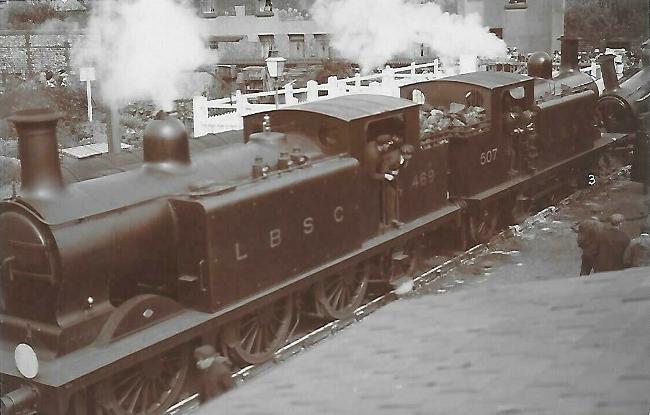
V. From driver Edwards' evidence it is clear that his brake valve handle was throughout in the full release, and not in the running position as prescribed in the Regulations. The effect then of connecting the train pipe of the engine with the storage pipe of the car, when the air pump was driven, would be to create pressure on the engine, in the main reservoir, auxiliary reservoir and train pipe ; and also in the storage pipe and storage reservoir on car 1327, to the extent to which the pump was capable. There is no evidence how long the pump was kept in action, but it is probable that the pressure throughout the system described rose to as much as 90 lbs. When it became necessary to apply the continuous brake, the reduction of air pressure in the engine train pipe would cause a tendency for the triple valve to fall, and the engine brake cylinder to be actuatedupon by pressure from the auxiliary reservoir. But the brake effect on the engine would be very alight, and the increase in effect very slow, because air pressure had to be reduced not only in the engine train pipe, but also in the storage reservoir on car 1327. The continuous outrush of air through the Driver's valve referred to by driver Edwards as occurring without brake effect is thus explained. There would, of course, be no application of the continuous brake upon the 8 coaches forming the train. The rate of retardation of the speed of the train, owing to so slight and gradual an application of brake effect upon one quarter only of its total weight, would be insufficient to prevent the collision that occurred.
VI. My final conclusions on this case are :-
(1) That the Westinghouse brake failed to control the train owing to incorrect coupling of the engine train pipe with the storage pipe on car 1327 by porter Dinnage. He is a man with only 10 months' service, and it is clear that the mistake which, I believe, he made was in part due to ignorance of continuous brake connections.
(2) The error in coupling would have been detected before the train started, if either:-
(a) Guard Ebbins had tested the continuous brake in the manner prescribed by the Regulations. It is possible also that with any considerable pressure in his gauge he might, by application of the continuous brake to the coaches, if he had been observing the speed of the train as it neared the platform at Littlehampton,have prevented the collision.
(b) Driver Edwards had examined the couplings before the train started, or tested his brake when passing the distant signal, or (in all probability) if he had whistled for the assistance of the guard when he found the brake was failing to act. He was aware of his duty in each of these respects. He had not been on duty an hour when the accident occurred.
(c) Station Foreman Catchpole had either assured himself in some way that the guard had properly tested the brake, or had examined the couplings on the train before it started. The responsibility for the collision lies with all these men, but, more heavily, in my opinion, upon the three last named, on account of their greater experience. It is a matter for regret that carelessness, or actual neglect, in respect of observance of Brake Regulations, which the case proves are necessary in the interests of general safety, is indicated by the conduct of a number of Railwaymen, especially so when there was ample time to give full effect to the Regulations.
VII. The case also shows that :-
(1) Some system of instruction in the general principles of continuous brakes, and in the variation of hose couplings, is advisable in the case of men who may be concerned with coupling and uncoupling.
(2) It is necessary to avoid the possibility of confusion arising from the employmentof a number of air pipes. The alternatives for consideration by the Company appear to be either :
(a) To unscrew 3 of the 4 hose pipe couplings when cars are used in ordinary service ;
or
(b) To provide coupling heads of smaller diameter upon the 3 additional pipes than the normal, 1 inch.
